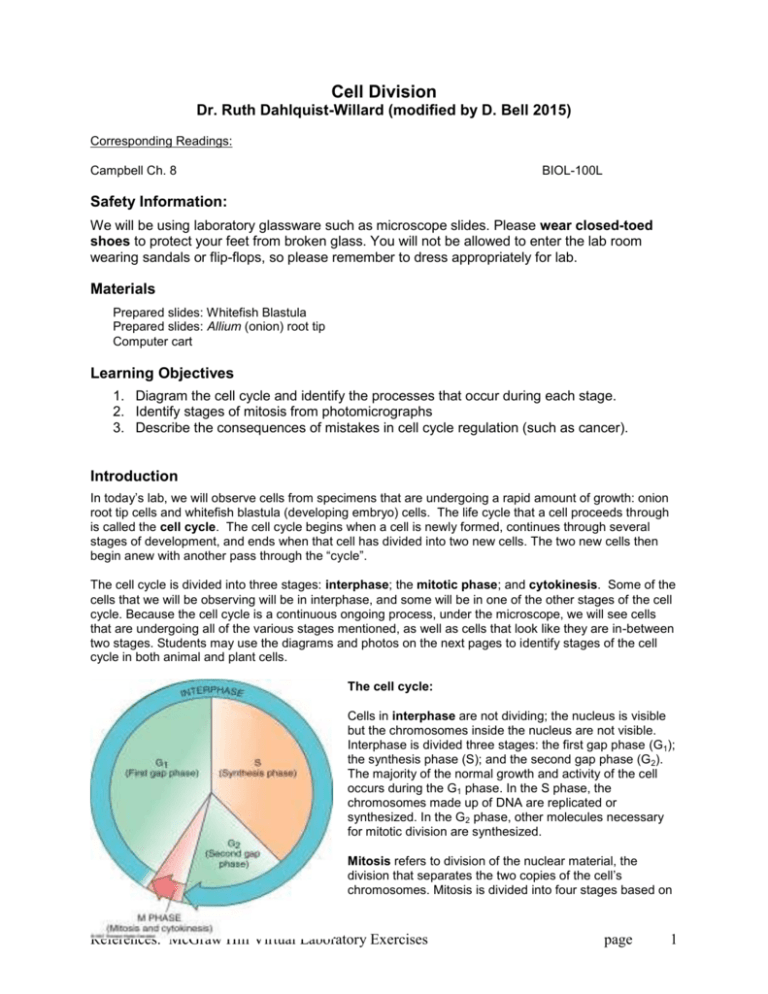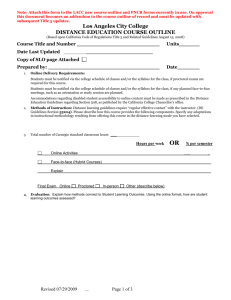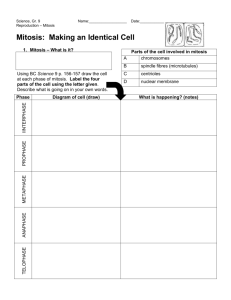Lab 4, Feb 3: Cell division
advertisement

Cell Division Dr. Ruth Dahlquist-Willard (modified by D. Bell 2015) Corresponding Readings: Campbell Ch. 8 BIOL-100L Safety Information: We will be using laboratory glassware such as microscope slides. Please wear closed-toed shoes to protect your feet from broken glass. You will not be allowed to enter the lab room wearing sandals or flip-flops, so please remember to dress appropriately for lab. Materials Prepared slides: Whitefish Blastula Prepared slides: Allium (onion) root tip Computer cart Learning Objectives 1. Diagram the cell cycle and identify the processes that occur during each stage. 2. Identify stages of mitosis from photomicrographs 3. Describe the consequences of mistakes in cell cycle regulation (such as cancer). Introduction In today’s lab, we will observe cells from specimens that are undergoing a rapid amount of growth: onion root tip cells and whitefish blastula (developing embryo) cells. The life cycle that a cell proceeds through is called the cell cycle. The cell cycle begins when a cell is newly formed, continues through several stages of development, and ends when that cell has divided into two new cells. The two new cells then begin anew with another pass through the “cycle”. The cell cycle is divided into three stages: interphase; the mitotic phase; and cytokinesis. Some of the cells that we will be observing will be in interphase, and some will be in one of the other stages of the cell cycle. Because the cell cycle is a continuous ongoing process, under the microscope, we will see cells that are undergoing all of the various stages mentioned, as well as cells that look like they are in-between two stages. Students may use the diagrams and photos on the next pages to identify stages of the cell cycle in both animal and plant cells. The cell cycle: Cells in interphase are not dividing; the nucleus is visible but the chromosomes inside the nucleus are not visible. Interphase is divided three stages: the first gap phase (G1); the synthesis phase (S); and the second gap phase (G 2). The majority of the normal growth and activity of the cell occurs during the G1 phase. In the S phase, the chromosomes made up of DNA are replicated or synthesized. In the G2 phase, other molecules necessary for mitotic division are synthesized. Mitosis refers to division of the nuclear material, the division that separates the two copies of the cell’s chromosomes. Mitosis is divided into four stages based on References: McGraw Hill Virtual Laboratory Exercises page 1 what is occurring with the chromosomes: prophase, metaphase, anaphase, and telophase. Cytokinesis is the division of the cell’s cytoplasm, organelles and cell membrane to form two new cells. The process of cytokinesis is different in plant and animal cells. During cytokinesis in plant cells, vesicles containing cell wall and cell membrane components line up along the mid-plane to form a cell plate, perpendicular to the mitotic spindle. New cell wall and cell membrane material is added until the two new cells are completely separated. In animal cells, a cleavage furrow is formed where the cell membrane pinches off the cytoplasm into two rounded spheres. We will observe plant cell division in the very tip of onion (Allium) roots. Plant root tips have meristem tissue, regions of active growth and cell division where the roots are growing in length,. We will observe animal cell division in cells from the blastula of a whitefish. The blastula is one of the stages of embryonic development, and thus is also undergoing a rapid amount of growth. Observing cells in these areas of rapid cell growth, improve our ability to observe cells undergoing all the different stages of the cell cycle. The following cartoon diagram illustrates stages of the cell cycle observed in typical animal cells: Exercise 6.1: Observing mitosis in whitefish blastula cells 1. Obtain a prepared slide of a cross-section through a whitefish blastula. The slide usually has several rows of stained round discs. Each disc is a thin slice made up of dozens of cells. Mount the slide under References: McGraw Hill Virtual Laboratory Exercises page 2 the microscope. Focus on the specimens, first using the 4X objective (red), then 10X, and then the 40X (high power- blue) in order to distinguish individual cells that make up the specimen disc. 2. Make drawings in your notebook of whitefish cells in each of the 4 stages of mitosis: prophase, metaphase, anaphase, and telophase. Title your drawings and make note of the magnification you are using (i.e. Whitefish Prophase at 400X magnification). Label the cellular structures that you can observe at each stage (chromosomes, spindle fibers, cell membrane, nuclear envelope, centrioles, etc.). You may refer to the diagrams on the previous page, but you are to draw the actual cells that you observe under the microscope. Note: they will not look exactly like the diagrams from the textbook! 3. Look for cells that are undergoing cytokinesis. Draw one of these cells and label its structures. 4. Before moving on, have the instructor check your identification. Instructor will assign a stage of mitosis and student will locate it on their slide, or instructor will indicate a cell and student must correctly identify the stage of mitosis. Exercise 6.2: Observing mitosis in onion root tip cells 1. Obtain a prepared slide of an onion root tip. Focus on the roots using the 4X objective, and then the 10X objective. Locate the very end of the root tip called the root cap (usually the rounded or pointed end of the specimen). Locate the meristematic zone, which is just above the root cap. If you are too far up from the root cap, you will not see many cells in the mitotic phase of the cell cycle. Once you have located the meristematic zone, switch to the 40X objective (high power- blue). 2. Make drawings in your notebook of onion cells in each of the 4 stages of mitosis: prophase, metaphase, anaphase, and telophase. Title your drawings and make note of the magnification you are using (i.e. Allium Prophase at 400X magnification). Label the cellular structures that you can observe at each stage (chromosomes, spindle fibers, cell membrane, nuclear envelope, cell wall, centrioles, etc.). You may refer to the diagrams on the previous page, but you are to draw the actual cells that you observe under the microscope. Note: they will not look exactly like the diagrams from the textbook! 3. Look for cells that are undergoing cytokinesis. Draw one of these cells and label its structures. Note: remember how plant cells differ from animal cells in this stage. 4. Before moving on, have the instructor check your identification. Instructor will assign a stage of mitosis and student will locate it on their slide, or instructor will indicate a cell and student must correctly identify the stage of mitosis. Answer the following questions in your Notebook: 1. Note that nuclei were not visible in some of the cells that you observed. Remembering that you are observing a thin section through an object, explain why some cells appear to be missing nuclei. 2. Construct a table in your notebook listing all stages of the cell cycle and briefly bullet point the most important events occurring at each stage. 3. Construct a table in your notebook comparing and contrasting the processes that occur in mitosis versus meiosis. 4. Explain the differences between mitosis and meiosis in terms of their functions. References: McGraw Hill Virtual Laboratory Exercises page 3 Exercise 6.3: The Cell Cycle and Cancer: Download and print the Howard Hughes worksheet on cell cycle and cancer. The web link has been provided by your instructor. References: McGraw Hill Virtual Laboratory Exercises page 4







